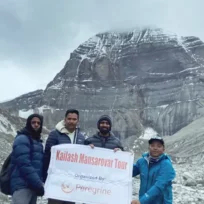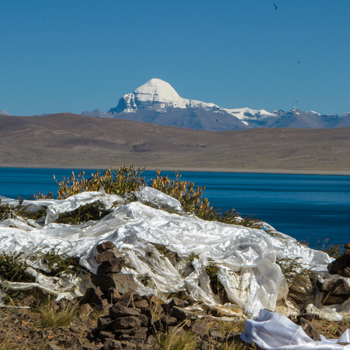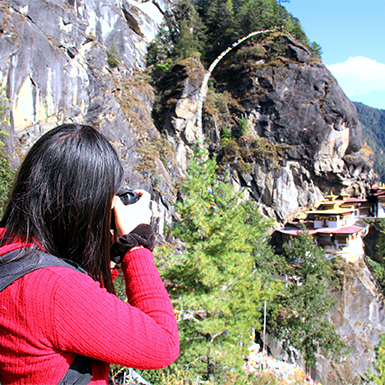Nestled high in the Tibetan Himalayas, Manasarovar Lake is more than just a scenic body of water. It’s a place of deep spiritual resonance, a sanctuary where tranquility meets the divine. Its crystal-clear waters and majestic surroundings beckon travelers and pilgrims alike, promising a tour of self-discovery and profound peace.
The lake’s calm, crystal-clear waters mirror the vast sky above, creating an atmosphere of peace and serenity. Majestic snow-capped peaks and expansive plains encircle the lake, amplifying the feeling of seclusion and tranquility. This serene environment fosters introspection and meditation, making it an idyllic sanctuary for those seeking spiritual renewal.
Spiritual Significance of Mansarobar Lake Revered by Many Faiths
Manasarovar Lake holds deep spiritual meaning for four major religions, each with unique beliefs and practices:
- Hinduism: Hindus venerate the lake as a manifestation of purity, a tangible representation of the mythical Lake Manasarovar. They believe bathing in its sacred waters washes away sins and paves the path toward moksha (liberation).
- Buddhism: Tibetan Buddhists associate the lake with the legendary Anavatapta Lake, where Queen Maya dreamt of conceiving Buddha. Pilgrims flock here seeking blessings, purification, and spiritual enlightenment.
- Jainism: Jains revere Manasarovar as the birthplace of Rishabhdev, their first Tirthankara (spiritual leader). This sacred site is a pilgrimage destination for those seeking spiritual growth and connection with their faith.
- Bon: The ancient Bon religion, predating Buddhism in Tibet, considers Manasarovar a sacred lake teeming with spiritual energy. Practitioners perform rituals and offer prayers here to tap into this powerful energy and receive blessings.

Awe-Inspiring Natural Splendor in a Remote Location
Manasarovar Lake’s unique location and breathtaking natural beauty make it an attractive pilgrimage site and natural wonder.
- High-Altitude Beauty: Nestled at 4,590 meters (15,060 ft) in the Ngari Prefecture of Tibet Autonomous Region, China, it is among the world’s highest freshwater lakes. This high altitude creates a distinct microclimate characterized by clear skies, thin air, and intense sunlight.
- Round Perfection: The lake’s almost perfectly round shape adds to its mystique. People often liken it to a mandala, a sacred geometric symbol in Buddhism and Hinduism that represents the universe.
- Reflective Waters: Manasarovar’s pristine waters mirror the snow-capped peaks, including the majestic Mount Kailash, creating a mesmerizing panorama that inspires awe and reverence.
- Rich Biodiversity: The lake and its surroundings host a variety of wildlife, such as the endangered bar-headed goose, the Tibetan wild ass (kiang), and the Tibetan gazelle. This thriving ecosystem further enhances the lake’s appeal as a natural treasure.
Where Myth and History Converge on the Tibetan Plateau
Manasarovar Lake, a shimmering gem nestled in the heart of Tibet, transcends its geographical beauty. Ancient myths and historical accounts interweave here, enriching its already captivating allure.
Legends and Myths: A Divine Tapestry
Diverse cultures have woven enchanting stories around Lake Manasarovar, painting a picture of a place where the divine touches the earthly realm:
Hinduism
- Hindus believe that Lord Brahma, the god of creation, manifested Lake Manasarovar within his mind, symbolizing pure divinity.
- They also revere it as the summer retreat of Lord Shiva and his wife, Parvati, further elevating its sacred status.
- A separate legend suggests that the lake emerged where the hand of Sati, Lord Shiva’s first wife, fell, linking it to the 51 Shakti Peethas, sites of immense spiritual power.
Buddhism
- Tibetan Buddhists associate Manasarovar with Anavatapta, a mythical wish-fulfilling lake renowned for its healing properties.
- They also believe that Queen Maya dreamt of a white elephant entering her womb at this site, signifying the conception of Buddha.
Jainism
- Jains hold Manasarovar sacred as the birthplace of Rishabhdev, their first Tirthankara (spiritual leader). This connection draws Jain pilgrims seeking spiritual enlightenment to the lake’s shores.
Bon
- The Bon religion, predating Buddhism in Tibet, honors Manasarovar as a sacred lake visited by its founder, Tonpa Shenrab. This visit solidifies its importance in this ancient Tibetan faith.

Historical References and Significance: A Timeless Pilgrimage
Manasarovar Lake’s importance extends beyond mythology. Historical texts and records confirm its centuries-old significance as a pilgrimage destination:
- Ancient Texts: Mentions of Manasarovar appear in Hindu scriptures like the Skanda Purana and the Mahabharata, as well as Buddhist texts and early explorers’ accounts.
- Pilgrimage Route: For generations, pilgrims have undertaken the challenging Manasarovar Lake pilgrimage, often combining it with a circumambulation (kora) of Mount Kailash. Devotees believe this spiritual trip purifies the soul and accumulates merit.
A Sacred Bond with Mount Kailash
Manasarovar Lake and Mount Kailash share an unbreakable spiritual connection for several religions. People often regard them as the axis mundi or center of the universe.
- Shared Pilgrimage: Many pilgrims undertake a combined pilgrimage, first bathing in the holy waters of Manasarovar and then circumambulating Mount Kailash. This dual trip is profoundly transformative, bringing one closer to spiritual enlightenment.
- Cosmic Balance: The lake and mountain symbolize complementary forces. Manasarovar represents the feminine principle of wisdom and purity, while Kailash embodies the masculine principle of strength and power. Together, they represent the harmony and balance of the cosmos.
A Natural Wonder in the Tibetan Highlands
Manasarovar Lake, nestled amidst the majestic Himalayas, is not merely a sacred site; it’s a geographical and ecological marvel. Its unique features and pristine environment make it a captivating destination for pilgrims and nature enthusiasts.
Altitude and Size: A High-Altitude Expanse
- Elevation: Perched at an impressive altitude of 4,590 meters (15,060 feet) above sea level, Manasarovar Lake Tibet claims the title of one of the world’s highest freshwater lakes. This lofty position contributes to its unique climate and ecological characteristics.
- Surface Area: The lake covers an area of approximately 412 square kilometers (159 square miles), making it a significant body of water in the region. Its vast size enhances its grandeur and offers a habitat for diverse flora and fauna.
- Depth: At its maximum, Manasarovar’s depths reach up to 90 meters (300 feet), holding a significant volume of freshwater. This depth creates diverse underwater environments, contributing to the lake’s ecological richness.
Surrounding Landscape and Climate: A Harsh Yet Beautiful Environment
- Dramatic Scenery: Snow-capped peaks, including the revered Mount Kailash, surround the lake, creating a breathtaking panorama. These mountains form a dramatic backdrop and influence the lake’s microclimate.
- High-Altitude Desert: The surrounding landscape is a high-altitude desert environment with arid plains, rocky outcrops, and sparse vegetation. The harsh conditions contribute to the lake’s pristine and untouched beauty.
- Extreme Temperatures: The climate around Lake Manasarovar is extreme, with freezing winters and cool summers. Temperatures can fluctuate significantly throughout the day, demanding careful preparation from visitors.
- Crystal-Clear Skies: Thanks to its high altitude and remote location, the lake features clear skies that provide breathtaking nighttime star views and create a genuinely awe-inspiring atmosphere.
Flora and Fauna: Adapting to Altitude
- Limited Vegetation: The harsh environment surrounding Lake Manasarovar supports limited vegetation. Hardy grasses, shrubs, and tiny alpine flowers manage to thrive in these challenging conditions.
- Aquatic Life: Despite its high altitude, the lake is home to various fish species, including the snow trout and the Tibetan loach. These fish have adapted to survive in the cold, oxygen-rich waters.
- Avian Diversity: Manasarovar Lake is an essential stopover for migratory birds, particularly the bar-headed goose, known for its incredible high-altitude flights over the Himalayas. Other bird species around the lake include the brown-headed gull, ruddy shelduck, and the Tibetan sandgrouse.
- Mammals: The surrounding grasslands and hills provide habitat for various mammals, including the Tibetan wild ass (kiang), the Tibetan gazelle, and the rare snow leopard.

Spiritual Oasis Revered by Many Faiths
The Tibetans honor Lake Manasarovar, tucked away on the high Tibetan Plateau, not just as a lovely lake but as a lake of religious importance, drawing pilgrims from all over the world for prayers and meditation.
Importance in Hinduism: Lord Shiva’s Divine Abode
For Hindus, Manasarovar Lake holds immense reverence. They believe Lord Brahma, the god of creation, created it. They also believe that Lord Shiva and his wife, Goddess Parvati, reside there during summer.
- Cleansing Waters: Devotees undertake the Manasarovar Lake pilgrimage to bathe in its sacred waters. Devotees believe bathing in the lake’s holy waters washes away sins and accelerates their tour towards moksha (liberation).
- Shakti Peetha: Legend claims that the lake emerged where the hand of Sati, Lord Shiva’s first wife, fell. This connection makes it one of the 51 Shakti Peethas, powerful energy centers sacred to goddess devotees.
Importance in Buddhism: The Wish-Fulfilling Lake
Tibetan Buddhists hold Manasarovar Lake significance in high esteem. It’s associated with Guru Rinpoche (Padmasambhava), a revered figure who is said to have meditated here and left his handprints on a rock.
- Anavatapta: Tibetan Buddhists identify the lake with the mythical Anavatapta Lake, known for its wish-granting abilities and healing powers.
- Queen Maya’s Dream: Tibetan Buddhists believe that Queen Maya, the mother of Buddha, dreamed of a white elephant entering her womb at Lake Manasarovar, a symbol of Buddha’s conception.
Pilgrimage Practices and Rituals: A Sacred Journey
A Manasarovar Lake pilgrimage is a significant undertaking for devotees. It often involves:
- Kora (Circumambulation): Pilgrims walk around the lake, a trip of about 88 kilometers (55 miles) that takes several days. Pilgrims believe this act purifies them and brings blessings.
- Bathing: A ritual dip in the holy waters is essential for cleansing the soul.
- Prayer and Meditation: The lake’s serene environment provides the perfect backdrop for prayer, meditation, and spiritual reflection.
- Offerings: Pilgrims often offer flowers, incense, and other items to the deities associated with the lake.
Major Festivals and Events: A Time for Celebration
Throughout the year, Lake Manasarovar comes alive with vibrant celebrations during religious festivals:
- Saga Dawa Festival: This major Buddhist festival, held in May or June, marks Buddha’s birth, enlightenment, and death. The celebrations at Lake Manasarovar are particularly vibrant, with pilgrims gathering to perform rituals and circumambulate the lake.
- Guru Rinpoche’s Birthday: Observed in July or August, this festival commemorates the birth of Guru Rinpoche. Devotees gather at the lake to offer prayers and participate in religious ceremonies.
- Hindu Festivals: Lake Manasarovar also hosts various Hindu festivals, where devotees perform rituals and seek blessings from the deities associated with the lake.
Your Ultimate Guide to Visiting Manasarovar Lake: A Sacred Himalayan Adventure
Manasarovar Lake, nestled high in the Tibetan Himalayas, beckons adventurers and spiritual seekers alike. This stunning lake boasts breathtaking scenery, deep religious significance, and a unique ecosystem. Let’s craft a practical guide to help you plan an unforgettable tour:
Choose the Right Time to Visit
Plan your visit to Lake Mansarovar between May and September for the most pleasant weather and the easiest acclimatization. The weather is milder during this period, easing your acclimatization to the high altitude.
- May-June: Experience pleasant weather and the vibrant colors of blooming wildflowers.
- July-August: These months are the warmest, but expect occasional rain showers.
- September: Enjoy clear skies, comfortable temperatures, and a popular time for pilgrims.
Avoid the winter months (October to April) as the region faces harsh conditions and heavy snowfall, making travel challenging and potentially dangerous.
Reach Manasarovar Lake: Two Scenic Routes
Getting to Mansarovar Lake involves a combination of air and land travel. Choose from these two main routes:
Lhasa Route
- Fly: Start your tour by flying into Lhasa, Tibet’s capital. Most international travelers will connect through major Chinese cities like Beijing or Chengdu.
- Continue by Road/Air: From Lhasa, you can take a scenic multi-day drive across the Tibetan Plateau for gradual acclimatization or a shorter domestic flight to a nearby airport.
Kathmandu Route
- Fly: Fly into Kathmandu, Nepal.
- Drive: Begin on a scenic overland tour to the Tibetan border, followed by a drive to Lake Manasarovar. This route also allows for gradual acclimatization.
Finding Accommodation: Options for Every Traveler
You’ll find various accommodation options near Mansarovar Lake, catering to different budgets and preferences:
- Guesthouses: Darchen and Chiu Gompa offer basic guesthouses with simple rooms and essential amenities.
- Hotels: Newer hotels with modern facilities have emerged in recent years, providing a more comfortable stay.
- Camping: For the adventurous, camping under the starry sky near the lake is an unforgettable experience. Be sure to pack all essential camping gear and prepare for cold temperatures.
- Monasteries: Some monasteries around Manasarovar Lake Tibet offer basic lodging for pilgrims, typically with shared facilities.
Permits and Regulations: Your Key to a Smooth Trip
Traveling to Tibet requires specific permits and adherence to regulations:
- Tibet Travel Permit: All foreign visitors must obtain a Tibet Travel Permit through a registered tour operator.
- Alien’s Travel Permit: You may need additional permits for specific areas like Mansarovar Lake and Mount Kailash.
- Group Travel: Independent travel is not allowed in Tibet. You need to join an organized tour with a licensed agency.
- Health Precautions: The high altitude can cause health issues. Consult your doctor before traveling and allow time for acclimatization to prevent altitude sickness.
Beyond the Sacred: Experiences at Mansarovar Lake for Every Traveler
Manasarovar Lake, a shimmering gem nestled high in the Tibetan Plateau, offers more than just spiritual solace. Its breathtaking landscape and unique ecosystem provide a playground for adventurers and nature enthusiasts alike.
Spiritual and Pilgrimage Activities: A Journey of the Soul
Lake Mansarovar holds deep religious significance for Hindus, Buddhists, Jains, and followers of the Bon religion. A Manasarovar Lake pilgrimage can be a transformative experience, often combined with a trek around the holy Mount Kailash. Here’s what you can experience:
- Kora (Circumambulation): Begin on a sacred walk around the lake, a three to five-day trek covering about 88 kilometers (55 miles). Pilgrims believe this ritual cleanses the soul and brings blessings.
- Bathing: Dip in the lake’s holy waters to purify yourself and connect with the divine.
- Prayer and Meditation: Find inner peace and clarity in the serene atmosphere of Lake Manasarovar, which is perfect for prayer and meditation.
- Visit Chiu Monastery: Discover this ancient Buddhist monastery on the lakeshore, a significant spiritual center steeped in history and tradition.
Trekking and Hiking: Explore the Himalayan Wilderness
The rugged terrain surrounding Mansarovar Lake offers incredible opportunities for trekking and hiking enthusiasts.
- Mount Kailash Kora: Challenge yourself with a trek around Mount Kailash, a sacred trip revered by many faiths. This multi-day adventure takes you through diverse landscapes and high-altitude passes.
- Gurla Mandhata Trek: Conquer Gurla Mandhata, the region’s highest peak, for stunning views of the lake and surrounding mountains. This more demanding trek requires proper acclimatization.
- Day Hikes: Explore the area’s rich flora, fauna, and stunning scenery on numerous shorter hikes around the lake.
Boating on Manasarovar Lake: Serenity on the Water
Gently glide across the serene waters of Manasarovar Lake on a peaceful boat ride. Admire the snow-capped peaks that ring the lake and experience its vastness from a unique perspective.
- Local Boats: Hire traditional wooden boats operated by local guides who can share fascinating insights about the area.
- Sunset Cruises: Witness the magical transformation of the landscape as the setting sun paints the mountains and the lake’s surface with golden hues.
Wildlife and Bird Watching: Observe Nature’s Wonders
Manasarovar Lake and its surroundings teem with diverse wildlife, attracting nature lovers and bird watchers.
- Bird Species: Spot the magnificent bar-headed geese as they migrate across the Himalayas. Keep your eyes peeled for brown-headed gulls, ruddy shelducks, and Tibetan sandgrouse.
- Mammals: Observe the graceful Tibetan wild asses (kiangs), Tibetan gazelles, and, if you’re fortunate, the elusive snow leopard.
- Flora: Discover the resilient plants that thrive in this high-altitude environment, including grasses, shrubs, and colorful alpine flowers.
Safeguarding Mansarovar Lake: A Shared Mission for a Fragile Ecosystem
Its breathtaking beauty and spiritual significance draw tourists and pilgrims, making sustainable practices and conservation efforts paramount.
The Current Environmental Status: Challenges Amidst Pristine Beauty
Though Mansarovar Lake remains relatively untouched, it faces a few environmental hurdles:
- Climate Change: The delicate balance of Lake Manasarovar’s ecosystem faces threats from climate change, such as rising temperatures and unpredictable rainfall patterns that impact water levels.
- Pollution: Increased tourism can lead to littering, improper waste disposal, and other forms of pollution that harm the lake’s water quality and the surrounding environment.
- Overgrazing: Nomadic herders and their livestock, integral to Tibetan culture, can unintentionally cause soil erosion and damage the habitat around the lake.
- Infrastructure Development: Road construction and other development projects can improve access but can disrupt natural habitats and water sources.
Conservation Efforts: A Collaborative Endeavor
Recognizing the importance of preserving Lake Manasarovar, a diverse group of people are actively working together:
Government Initiatives
- The Chinese government has designated the Manasarovar Lake area as part of the Mount Kailash Nature Reserve, providing legal protection and regulating activities within its boundaries.
- They have also limited development and construction activities around the lake to minimize environmental impact.
- The government actively promotes sustainable tourism practices to balance economic benefits with the need to protect the lake’s fragile ecosystem.
Local Communities
Local communities are key players in safeguarding the environment. They actively participate in waste management programs, monitor water quality, and educate visitors about responsible behavior around the lake.
International Organizations
The United Nations Environment Programme (UNEP) and the International Union for Conservation of Nature (IUCN) help protect the lake’s unique biodiversity by supporting research and conservation initiatives.
Responsible Tourism: Your Part in Preserving Manasarovar Lake
As a visitor, you have a unique opportunity to help protect the beauty and sanctity of Manasarovar Lake. Here’s what you can do:
- Minimize Waste: Bring your reusable water bottle and avoid single-use plastics. Please dispose of all waste properly or take it when you leave.
- Respect Local Culture and Wildlife: Embrace local customs and traditions and avoid disturbing wildlife or their habitats. Be mindful of the lake’s spiritual significance and act respectfully.
- Choose Sustainable Options: Opt for eco-friendly accommodations and tour operators prioritizing environmental sustainability and supporting local communities.
- Educate Yourself and Others: Learn about the lake’s fragile ecosystem and share your knowledge with fellow travelers to inspire responsible behavior.
Manasarovar Lake Travel Guide: Responsible Tourism Tips
- Pack Light: The less you bring, the less waste you’ll create.
- Support Local Artisans: Purchase locally made souvenirs and products to support the local economy.
- Choose Eco-friendly Transportation: Opt for shared transportation or walking/cycling whenever possible to reduce your carbon footprint.
- Conserve Water: Water is a precious resource at high altitudes, so use it sparingly.
- Leave No Trace: For a sustainable adventure, pack out all waste and embrace “Leave No Trace” practices to tread lightly on the environment.








